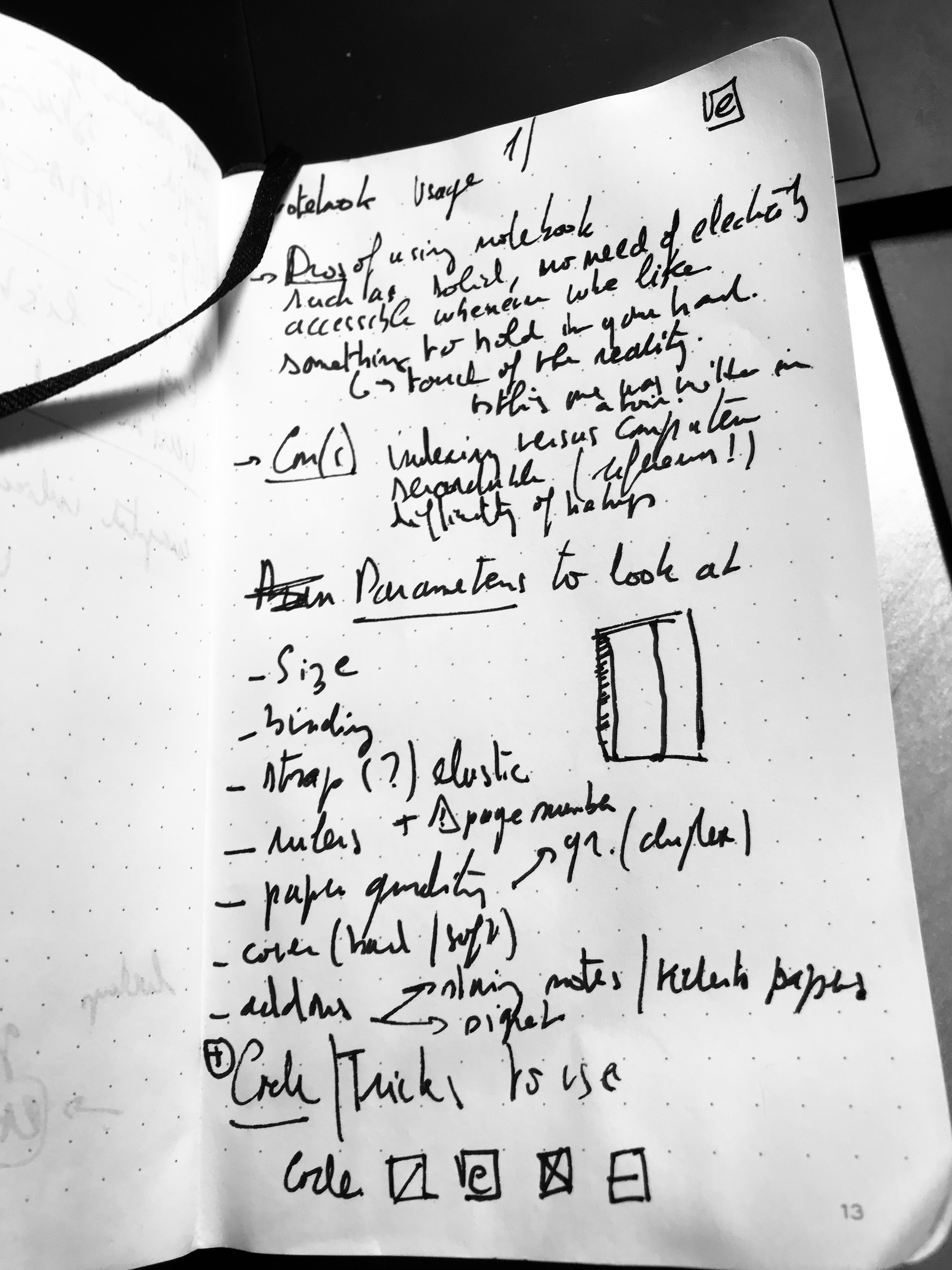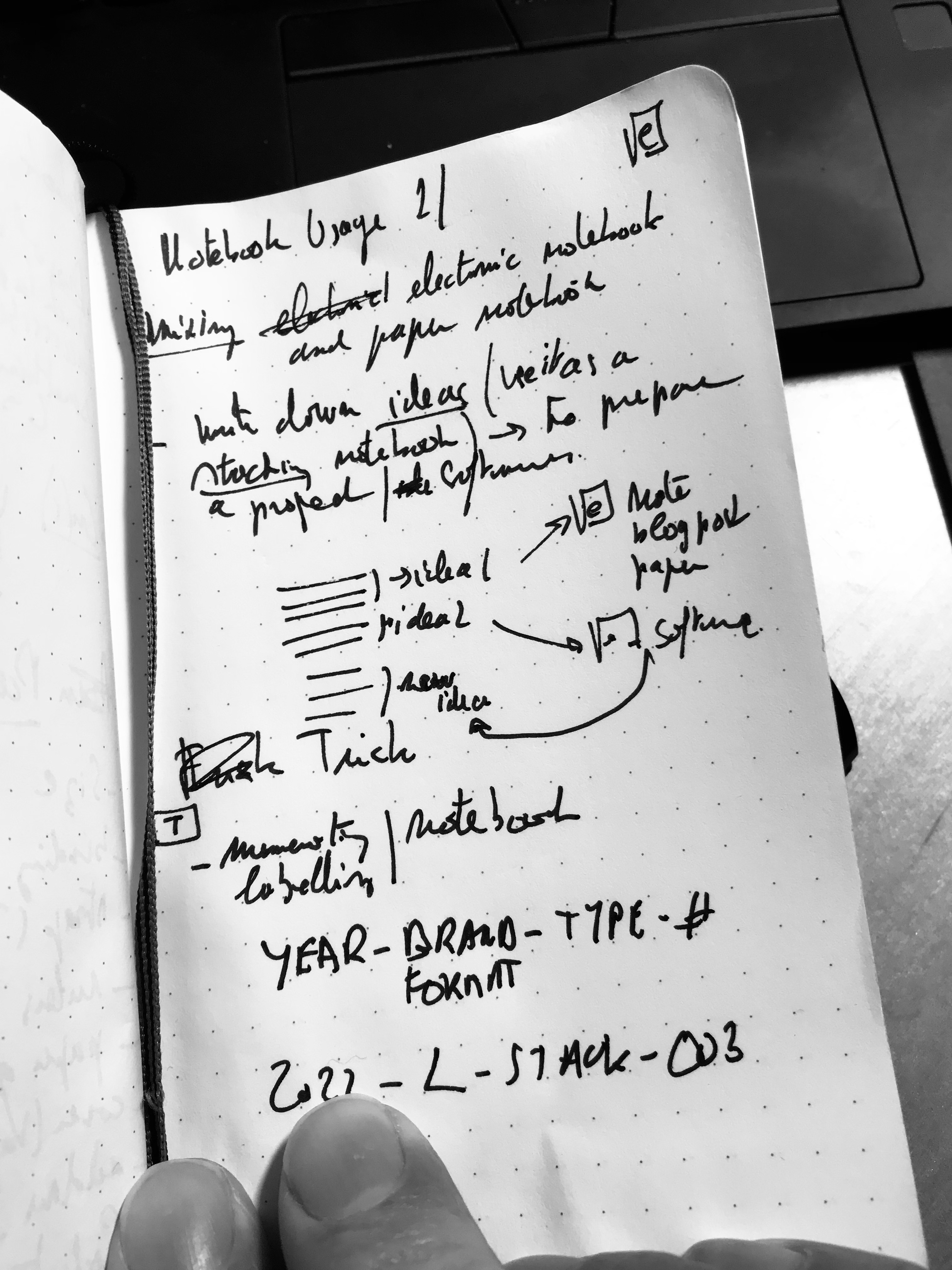Paper notebook usage
Paper notebook usage - how do I use and choose a paper notebook?

In today’s tech-driven world, paper notebooks may seem outdated and old-fashioned. However, I have found them to be a valuable tool for supporting my work and creative process. I have been using paper notebooks for years, and have kept them for archiving purposes as well as to track the evolution of my practices. This page is a summary of what I have learned from this process, and will be regularly updated with my successes and failures in note-taking.
My paper notebook process is strongly linked with my electronic note (I use nb1 and did use Joplin previously2).
Why I used a mixed model of paper and electronic notes-taking? It’s mainly due to the pros versus the cons of the paper notebooks.
The pros are
- being rock-solid,
- no need of electricity or paper to use it,
- accessible whenever you like,
- something to hold in your hand (like having in your hand, your project and makes it real).
The cons are
- easy to lost and it’s difficult to make backups,
- the difficulty of indexing and searching in a paper notebooks. Searching for a single word in your electronic notes is fast, accurate and precise.
My creative process is usually very comparable to the pattern described as WikiStacking in communitywiki.org. Before starting a project (can be a software project, an art project or even a business project), collecting and stacking information is a regular activity. A paper notebook is a simple and easy tool for doing so. I usually by stacking set of ideas, informations or concept into a free flow of writing. You can see an example below for writing this noteboook usage page, the initial stack of ideas.

This example is extracted from my notebook 2022-L-STACK-0033 (it’s a Leuchtturm1917 A6 pocket - dotted notebook). These notes were written carelessly in a crowded train wagon. You can see the original derivation of the first notes by reading this page. That’s exactly the great aspect of a notebook, it’s a starter to turn your ideas into a reality. As you can see, I use dotted page because it gives me freedom to write where I like but I can still use it if I need to write a diagram and follow some rulers. Starting to write is the most important step. Then your project is starting in some reality because of its existence in a notebook.

As you can see, I have some codes of the top right of the page. The e value within a Pi is used as a reminder to me that I need to transpose these notes into an electronic version. I have very simple code for the TODO notes, like partially done or fully done.
Parameters for selecting a notebook
If I want to acquire a paper notebook, I usually look at the following parameters. It also depends of what will be the use of the notebook. My main uses are the following:
- Stacking ideas (writing ideas for the initial discovery of project),
- Final notes (writing more complete ideas which will be used for reference later on),
- Art sketching/support (related to my artist work).
Size
My two favorite size for notebooks are A5 and A6. The sizes that I tested are the following:
- A5 - 145mm x 210mm
- A6 - 105mm x 148mm
- pocket size - 90mm x 140mm (Moleskine original size)
- passport size (B7) - 90mm x 125mm
The A6 size is perfect for wandering use as it fits in a pocket. The A5 size is more suitable for office or meeting use.
There is also the B7 (88mm x 125mm) which is a bit smaller than A6 and the size of a passport. I find it a bit too small for day-to-day use.
Paper quality
There is huge variation between the paper quality for the different paper-based notebooks. It doesn’t depend of the brand alone but also the model or the usage of the notebook. Usually sketching notebooks are with a higher gsm (grams per square meter) where a traditional note-taking notebook would be around 80 gsm.
The paper quality is also important if you want to avoid the “ghost” on the next page when writing. Usually good quality notebook limits such “ghost” effect but it’s not rare to see low quality notebooks having this effect. Then it’s becoming nearly impossible to use your notebook pages double-sided.
Concerning the color of the pages, not all notebook are using white paper but sometime a kind of yellowish paper. I personally like clear white paper especially for sketching and drawing. But it can be a matter of taste.
Stone paper
There are many type of papers used by notebook but the majority are make of real paper. But there are some exception like the “stone paper” which are made of mineral and HDPE. Those papers are super solid and useful under extreme conditions such as seen in laboratories or extreme outside environment. Not really my cup of tea as these often lack some classical paper properties required for fast ink drying. I usually avoid such paper when buying a notebook.
Page type
There are many page types in paper notebook. Page types includes:
- Ruled,
- square grid,
- plain,
- dotted.
My preference goes for dotted (I mean lightly dotted) as it’s a kind of plain paper with the ability to keep some structure when required. I use plain for my art sketching support.
Special type project management
There are many companies having creative page type from project management to-do list to more classical diary style. I tried some but it’s difficult to escape the page format when needed. If I need special type page, I tend to print custom pages (like for TODO lists) or use a post-it inside the notebook itself.
Binding
The binding of the notebook sounds like a non-critical element but it’s the most critical one. I remember buying low-cost notebook where after 4 weeks of usage, you are loosing pages in your bag. Avoid the only glue-based binding, it’s usually a source of issue. Usually it’s mixed with loop stitches (or sometime combined with perfect bound or tape bound) to make the notebook more solid.
There are also notebook with spiral. I avoid the notebook with a spiral or wirebound binding like the plague because these tend to broke in my bag or mess-up with other stuff.
Another important aspect, a paper notebook needs sometime to lie flat properly. And it highly depends of the binding. Test it and see if you can easily open it and keep it without too much pressure.
Strap/Elastic closure
Having an elastic is a must for a paper notebook. There are different reasons such as:
- If you put small papers, notes or tickets, these are kept inside the notebook.
- Another reason, if you have bag with a lot of things inside, you might crush the pages of the notebook. When it’s closed with an elastic, such issue is less prone to happen.
Good paper notebook tend to have a strap/elastic but some brands don’t have one. If you have a notebook you really like and don’t have an elastic. There are elastic including sometime paper clip bookmark which can do the job. Natural rubber band (more resilient than plastic ones) can also do the job and can be very useful as these are very extensible.
Cover
Soft cover and hard cover is usually a matter of taste. I tend to prefer a hard cover for A5/A4 size but for pocket-size notebook, soft covers are more flexible when you have to squeeze the notebook in a small bag or pocket. I tend to prefer black cover (nice to avoid the dirt over the time) and writing with white-acrylic pen on it with a Posca PC-1MR or similar pen.
Addons
bookmarks
One bookmark is the minimum, nowadays paper have one or more bookmark. Having two is the most convenient setup for me. As you can label a start set of pages and the current one. If your notebook is missing a bookmark, hard bookmark can also do the job.
Brands
I only mention the brands of the notebooks I used and found useful. The really crappy brands are not mentioned.
Leuchttrum 1917
Leuchtturm1917 produces an impressive set of Notebook and maybe one of my favorite is their A6 notebook. The various products from them is quite solid and still cost a reasonable price. These often come with two bookmarks and pages are numbered. The minor drawback is the page color is a bit yellowish but the paper quality is great even for 80 gsm.
Moleskine
Moleskine was one of my favorite brand before the improvements done by other brands. Their sketchbook are great and really nice if you travel a lot. The classical collection (9x14cm) with soft or hard cover is quite nice but without page numbering. The Leuchttrum 1917 A6 is a bit larger. Depending of the project, pocket size versus A6 size is often a dilemma. The pricing for Moleskine is a bit too much sometime but if you don’t consume a lot of notebook per year, it’s maybe a good deal.
Bindewerk
Bindewerk produces a large of notebook and their sketchbook (INSPIRATION) 160gsm (blank) are really great.
They have also a large set of solid basic notebooks.
Dotgrid
Dotgrid produces a large set of notebook. Unfortunately many of those are bounded with wirebound binding. The others are really good and rock-solid especially the dot-grid journal.The paper quality is impressive, the elastic closer is usually pretty good. Just the page numbering is missing…
Tricks and Hacks for your Notebook

Below you can find, my original Moleskine hack page from 2009 with some recent additions.
Numbering pages
Many brands now include page numbering but it’s not always the case. Then you must not forget to number the pages if you use your notebook as a stack of information and you need an index to find back easily a topic. You can also do “double numbering” to complement the existing numbering of the pages, especially when you use your notebook as a stack. You can also strike through the number to indicate if the page is no more important or underline it to mention it as an important page.
Name and number your notebook
YEAR-BRAND/FORMAT-TYPE-#
Such as 2022-L-STACK-003 which is the notebook used to do this initial page.
The type is the use-case of the notebook
STACKis stacking information or original ideas in different pages.FINALis the final notes which can be archived or published as it.SKETCHis the sketching of artistic or photographic work.
The # is just a sequence often starting at 001 per year.
Cornell note-taking methods and notebook
There are special page format to support note-taking strategy such as The Cornell Note Taking System. This process can be useful sometime and then you can add printed pages in your notebook to follow such a specific process.
A LaTeX template for Cornell note-taking is available as GitHub gist.
Paper clip
Having two or three paper clips in your notebook can be useful for various use-cases:
- For a stacking notebook, combining multiple pages into a single stack.
- For a sketching notebook, it’s not uncommon to keep small photos, notes, evidences or traces with other notes.
- and a paper clip can be useful for many other things.
TODOs list
TODOs are often very common in notebooks but it’s an easy filler. Using post-it notes in the notebook helps to reduce the waste of pages and can be easily replaced when the TODO list is over.
Disclaimer
I didn’t receive any free paper notebook to do this page. I’m not a bloody influencer and I did this to give ideas to other using paper notebooks. Nevertheless if you are a producer of paper notebooks, I won’t be against to receive some samples for testing. But be careful, I might be negative in reviews or provide feedback to buy from another manufacturer.
-
Copying from my electronic notebook to my public website, it’s a single command.
cp /home/adulau/.nb/home/post/note-usage.md /home/adulau/git/foo.be/_pages/paper-notebook-usage.markdown↩ -
I moved to nb to Joplin as I wanted a git back-end for my daily notes. Both are two incredible open source software for notes-taking. ↩
-
All my paper notebook are labelled with a name and number. Check out the tricks section. ↩